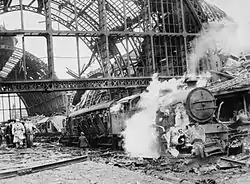Middlesbrough railway station
Middlesbrough railway station serves the large town of Middlesbrough in North Yorkshire, England and is managed by TransPennine Express.
 Middlesbrough railway station in 2011 | |
| Location | Middlesbrough, Middlesbrough England |
| Coordinates | 54.579100°N 1.234720°W |
| Grid reference | NZ495207 |
| Managed by | TransPennine Express |
| Platforms | 2 |
| Other information | |
| Station code | MBR |
| Classification | DfT category C1 |
| History | |
| Original company | Middlesbrough and Redcar Railway |
| Pre-grouping | North Eastern Railway |
| Post-grouping | London and North Eastern Railway |
| Key dates | |
| 1830 | First station (wooden shed) |
| 1839 | Second station (Commercial Street) |
| 26 July 1847 | Third station opened |
| 16 December 1874 | Third station closed |
| December 1877 | Third station replaced by current station[1] |
| 3 August 1942 | Station extensively damaged in air raid |
| Passengers | |
| 2015/16 | |
| 2016/17 | |
| 2017/18 | |
| 2018/19 | |
| 2019/20 | |
| Notes | |
Passenger statistics from the Office of Rail and Road | |
The main station layout consists of an entrance hall with ticket office, large concourse/waiting area and two covered platforms that are each subdivided into two sections i.e. platform 1 (1a and 1b) and platform 2 (2a and 2b). Two freight lines bypass to the north of the station.
The station is staffed and has a range of facilities including a cafe / bar, newsagent, cycle storage, toilets and lifts.[2] Various screens throughout the station give information on train arrivals and departures.
Car parking is situated just to the east of the station and can be accessed via Exchange Square and Wood Street and by footpath directly to the station. A drop-off point is located at the front of the station close to the main entrance.
According to the Office of Rail and Road statistics, Middlesbrough railway station is the fourth busiest in the North East region, with 1,312,402 total entries and exits (2019–20 period).[3]
History
%252C_Yorkshire_(geograph_6510489).jpg.webp)
The first railway line was opened in the area as long ago as December 1830 as an extension of the Stockton and Darlington Railway to connect with the port of the then new town of Middlesbrough. From the opening of the line until 1837, passengers were served by a wooden shed on the route to the riverside coal staithes. In 1837 the line was extended along Commercial Street to the new Exchange and in 1839 a more substantial station was built on Commercial Street.[4][5]
In June 1846, a branch off the Stockton and Darlington Railway line extending eastwards to Redcar was opened by the Middlesbrough and Redcar Railway Company. Situated on the Redcar branch line on the southern edge of the new town, a new passenger station was designed by John Middleton and opened on 26 July 1847. As the town expanded rapidly southwards during the second half of the 19th Century however, the 1847 station was unable to cope with the traffic growth. Due to the design of the station not lending itself to enlargement it was therefore demolished in 1874 and replaced by the current much larger station, opened in December 1877. The Commercial Street station, increasingly isolated from the town centre by the opening of the Redcar branch line, became a goods station before eventually being demolished.[6][7][8]
The current 1877 station was designed by the North Eastern Railway's chief architect, William Peachey, with an ornate Gothic style frontage. Behind this an overall roof of elliptical design once existed. Constructed out of wrought iron of lattice design, with glass covering the middle half and timber (inside)/slate (outside) covering the outer quarters. The two end screens were glazed with timber cladding around the outer edges. The roof was high in relation to its width.[9]


The elliptical roof was severely damaged in a German daylight air raid in the afternoon of 3 August 1942[10][11] and eventually removed in 1954, to be replaced by the current design over the concourse and platforms.[12]
A major refurbishment of the station took place during 2017 and 2018 with repairs carried out to the station's roof and stonework and upgrading of the Wood Street car park.[13] New information screens were also installed as part of the refurbishment.
In June 2020, Tees Valley Combined Authority announced a new £35 million plan to transform the station. Phase 1 of the work will see the extension of platform 2 giving the station increased capacity to accommodate more trains to Whitby and Newcastle; and planned for late 2021, the re-introduction of direct LNER trains from Middlesbrough to London. Phase 2 of the work will include a new £6.5 million entrance with accompanying business units being created on Zetland Road with access to the station subway being part of the plans. A third phase could see a new platform 3 built, with accompanying glass frontage and concourse facing out onto Bridge Street West further increasing train capacity within the station.[14][15][16] Construction on the first phase began in January 2021.[17]
Station Masters
- John Robinson ???? – 1877[18]
- A. Pearson 1877 – 1891
- Thomas Byers ???? – 1911
- Consett Walker 1911[19] – 1927
- G.D Jackson 1927 (afterwards station master at Glasgow Queen Street)
- Edwin Weavers 1927 – 1932 (afterwards station master at Manchester Central)
- Mark Lupton 1933 – 1939[20] (formerly station master at Malton)
- R.P. Haw 1939 – 1940[21]
- J.J. Luckley 1940 – 1942
- Matthew Albert Metcalfe 1942 – 1955 (formerly station master at West Hartlepool)
- H. Thompson 1955 – 1959 (afterwards station master at York)
- T. Jackson 1960 – ????
- G.F. Weatherley ???? – 1961
- D. Finburg 1962 – 1963
- William Lake 1963 – ????
- D.W. Cooper ???? – 1965
- J.R. Brown 1965 – ???? (formerly station master at Grangetown)
Service and frequency
Route 2: Durham Coast Line | ||||||||||||||||||||||||||||||||||||||||||||||||||||||||||||||||||||||||||||||||||||
|---|---|---|---|---|---|---|---|---|---|---|---|---|---|---|---|---|---|---|---|---|---|---|---|---|---|---|---|---|---|---|---|---|---|---|---|---|---|---|---|---|---|---|---|---|---|---|---|---|---|---|---|---|---|---|---|---|---|---|---|---|---|---|---|---|---|---|---|---|---|---|---|---|---|---|---|---|---|---|---|---|---|---|---|---|
| ||||||||||||||||||||||||||||||||||||||||||||||||||||||||||||||||||||||||||||||||||||
Route 5: Esk Valley Line | |||||||||||||||||||||||||||||||||||||||||||||||||||||||||||||||||||||||||||||||||||||||||||||||||||||||||||||||||||||||||||||||||||||
|---|---|---|---|---|---|---|---|---|---|---|---|---|---|---|---|---|---|---|---|---|---|---|---|---|---|---|---|---|---|---|---|---|---|---|---|---|---|---|---|---|---|---|---|---|---|---|---|---|---|---|---|---|---|---|---|---|---|---|---|---|---|---|---|---|---|---|---|---|---|---|---|---|---|---|---|---|---|---|---|---|---|---|---|---|---|---|---|---|---|---|---|---|---|---|---|---|---|---|---|---|---|---|---|---|---|---|---|---|---|---|---|---|---|---|---|---|---|---|---|---|---|---|---|---|---|---|---|---|---|---|---|---|---|
| |||||||||||||||||||||||||||||||||||||||||||||||||||||||||||||||||||||||||||||||||||||||||||||||||||||||||||||||||||||||||||||||||||||
From the station, Northern Trains provides local services on three lines. Services are currently operated by a fleet of Class 156 and Class 158 DMUs. As of the December 2019 timetable change, service and frequency is as follows:
- Durham Coast Line: An hourly service between Middlesbrough and Newcastle. Most trains continue on to Hexham or Carlisle.[22]
- Esk Valley Line: An hourly service between Middlesbrough and Nunthorpe, with six trains per day (four on Sunday) continuing on to Whitby. Most trains commence from Hexham or Carlisle. Two additional services operate as far as Battersby or Castleton Moor (Monday to Saturday only).[23]
- Tees Valley Line: A half-hourly service between Saltburn and Darlington, with one train per hour continuing on to Bishop Auckland.[24]
TransPennine Express also operate an hourly service from Redcar Central to York, Leeds and Manchester Airport.[25][26] Services are operated by a fleet of Class 185 DMUs, which are due to be replaced by the new Nova 3.[27]
| Preceding station | Following station | |||
|---|---|---|---|---|
| TransPennine Express North TransPennine | ||||
| Terminus | Northern Trains | |||
| Northern Trains | ||||
| Northern Trains | ||||
| Future services | ||||
| Newcastle | Northern Connect Carlisle – Middlesbrough |
Terminus | ||
| Disused railways | ||||
| Terminus | Middlesbrough & Guisborough Railway | Ormesby | ||
Notes
- "Railway Architecture of North East England : Middlesbrough Station". W. Fawcett, 2011. Retrieved 31 March 2014.
- "National Rail Enquiries : Middlesbrough (MBR)". National Rail. Retrieved 31 March 2014.
- "Estimates of station usage". Office of Rail and Road Website. Retrieved 28 December 2020.
- "Railway Architecture of North East England : Middlesbrough". W. Fawcett, 2011. Retrieved 28 December 2020.
- "December 1861 map of Middlesbrough North Riding: A Vision of Britain Through Time". University of Portsmouth and others. Retrieved 11 December 2015.
- Body 1988, pp. 118–9
- "Railway Architecture of North East England : Middlesbrough Station". W. Fawcett, 2011. Retrieved 31 March 2014.
- "Yorkshire 6 (includes: Billingham; Middlesbrough.) Surveyed: 1853 Published: 1857". Old Maps Online: National Library of Scotland. Retrieved 4 January 2021.
- Delplanque, Paul. "Middlesbrough Railway Station...Then and now". GazetteLive. Retrieved 21 January 2011.
- Hitches, M – Steam Around Middlesbrough (Amberley Publishing, 2014) p. 69
- "On this day in Yorkshire 1942: Train Missed Middlesbrough Bombing by Minutes". The Yorkshire Post. 3 November 2016. Retrieved 17 July 2017.
- "Railway Architecture of North East England : Middlesbrough Station". W. Fawcett, 2011. Retrieved 26 November 2015.
- "Middlesbrough Railway Station: £2.7m refurbishment will start in the new year". GazetteLive. Retrieved 30 December 2016.
- "Tees Valley Mayor Launches £35Million Station Transformation To Deliver More Trains To Boro". Tees Valley Combined Authority Website. Retrieved 12 June 2020.
- "Middlesbrough Railway Station set to be transformed with platform extension among improvements". TeessideLive Website. Retrieved 11 June 2020.
- "The Middlesbrough Station 'rejig' that will allow London-bound train services". TeessideLive Website. Retrieved 12 June 2020.
- Arnold, Stuart (25 January 2021). "London trains on the way this year as long-awaited work begins at Middlesbrough station". Teesside Live. Retrieved 26 January 2021.
- "Death of the Middlesbrough Station Master". Daily Gazette for Middlesbrough. England. 3 April 1877. Retrieved 9 September 2017 – via British Newspaper Archive.
- "New Stationmasters". Hartlepool Northern Daily Mail. England. 17 March 1911. Retrieved 9 September 2017 – via British Newspaper Archive.
- "Middlesbrough's Stationmaster Dead". Daily Gazette for Middlesbrough. England. 13 June 1939. Retrieved 9 September 2017 – via British Newspaper Archive.
- "Stationmaster's New Appointment". Newcastle Journal. England. 27 February 1940. Retrieved 9 September 2017 – via British Newspaper Archive.
- "Train times: Nunthorpe and Middlesbrough to Newcastle and Metrocentre" (PDF). Northern Trains. 15 December 2019. Retrieved 26 March 2020.
- "Train times: Middlesbrough to Whitby (Esk Valley Railway)" (PDF). Northern Trains. 15 December 2019. Retrieved 26 March 2020.
- "Train times: Bishop Auckland and Darlington to Middlesbrough and Saltburn" (PDF). Northern Trains. 15 December 2019. Retrieved 26 March 2020.
- Havery, Gavin (15 December 2019). "New train service pulls into Redcar". The Northern Echo. Retrieved 26 March 2020.
- "TransPennine Express: Network Map" (PDF). TransPennine Express. December 2019. Retrieved 26 March 2020.
- "TransPennine Express launches Nova fleet". Railway Gazette International. 25 November 2019. Retrieved 26 March 2020.
References
- Body, G (1988). PSL Field Guides – Railways of the Eastern Region Volume 2. Wellingborough: Patrick Stephens Ltd. ISBN 1-85260-072-1.
External links
| Wikimedia Commons has media related to Middlesbrough railway station. |
- Train times and station information for Middlesbrough railway station from National Rail